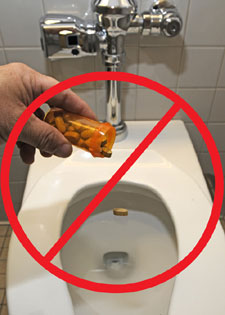How do you think excess pharmaceutical waste is disposed of? You may not notice it in your water, but pharmaceutical waste has been contaminating fresh water. When people need to dispose of drugs they are no longer using, instead of contacting a pharmacy, most people will simply flush the pills down the toilet. Where do they go after being flushed down the toilet? They do not go into a special treatment plant, but into our supply of water. When they drink a glass of water, some people are unwittingly taking pills that were not prescribed to them. This can be extremely dangerous because ingesting foreign medications can lead to extreme side effects, and possibly death. The waste of certain drugs have been identified to cause breast and prostate cancer, as well as some neurological disorders. Pharmaceutical wastes in the water supply do not occur only in developing countries. In the United States, many people are faced with this problem. Researchers have identified unwanted traces of pharmaceutical drugs in around 40 million Americans. When the Associative Press National Investigative Team researched the presence of pharmaceuticals in public drinking water in 2008, they found that traces of anti-anxiety pills were found in water used by over 18 million people in California. They also found mood-stabilizing medicines in water used by 850, 000 people in New Jersey. According to the AP, pharmaceutical waste has been shown to impede the growth of kidney cells, cause inflammation of blood cells, and cause cancer cells to spread faster. These ailments can be fatal.
As well as harming humans, pharmaceutical waste in water can harm animals, disrupting ecosystems. Drugs ingested by fish cause feminization of male fish. This prohibits males(or former males) from mating thus causing a decrease in number of eggs and population. As well as impacting the fish, the decline of the fish population has a negative effect on the organisms who prey on them, causing those predators to starve. Species on which major food chains rely -- such as zooplankton and earthworms are also threatened by pharmaceutical waste. This is tremendously worrisome, because if the species at the bottom of the food chain are threatened, the rest of the food chain that relies on these species – including humans and much of the food we eat - is also in jeopardy. This is happening in not only one, small stream. According to the EPA, pharmaceuticals are present in “any water body influenced by raw or treated sewage, including rivers, streams, ground water, coastal marine environments, and many drinking water sources”.
The U.S. Geological Survey found low levels of pharmaceuticals in 80 percent of the rivers and streams sampled, in 1999 and 2000.
If you have any unwanted medications, DO NOT flush them down the toilet or even throw them in the trash! Instead, contact the place where you purchased them from, or another pharmacy. Before trying to dispose of your excess medication, read the direction on the label, in case they provide some guidance. Most treatment plants do not have the technology to filter waste from water, which is why, even after treatment, chemicals from drugs still remain in the water. Hopefully, in the future, all residue of medications in water will be eliminated, and places to deposit unwanted remains of medications will expand to every pharmacy.



No comments:
Post a Comment